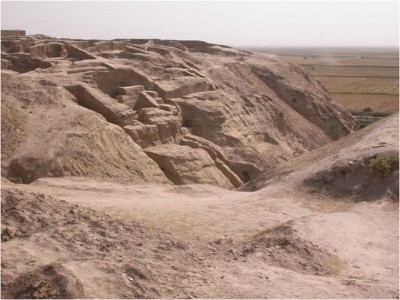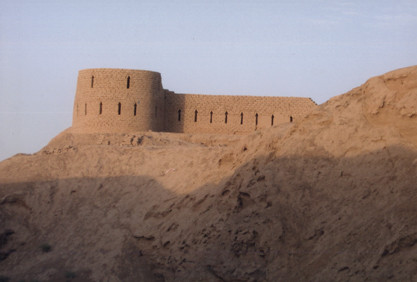On the steep bank of the Amu Darya River, 30 kilometers west of Termez there are the ruins of the ancient city of Kampyrtepa, identified by scientists with the legendary Alexandria on the Oxus - Alexandria Oxiana (Alexandria on Amu Darya). The total area of the preserved part of the fortress is about 4 hectares. Kampyrtepa is a citadel, surrounded by a moa and the "lower city" walled with towers.
Mastering the Citadel which had multimeter layers starting from the Hellenistic era had been started at the end of the IV century BC. Building of "the lower city" under a unified plan at the beginning of the I century AD and lasted until the reign of the Kushan king Kanishka I (the first third of the II. BC).
The monument discovered by the academician E.V. Rtveladze in 1972, was investigated by him for 30 years. Today more than 70% of its territory has been studied. Kampyrtepa fortress possesses a number of bright characteristics. The massif of a single kushan housing estate opened here dates back to the reign of the kings from Soter Megas to Kanishka I (the second half of the I century BC - the first half of the II century AD.). The structure of material culture of these quarters is a sample of formation and flourishing of the period of Kushan Empire.
Bactrian detachment of Central Asian archaeological expedition of the Institute of Archaeology under the direction of N.D.Dvurechenskaya there began excavation began excavating the eastern part of the "lower city" of Kampyrtepa in 2004. Till that time it used to be considered that in the entire territory of "the lower city" the residential quarters were built by a unified plan in the early Kushan period (I century AD) and that earlier building had never existed. However already during the first season of works in the studied part of the monument under Kushan layers it was succeeded to reveal three more construction periods, namely: early Hellenistic, Greek-Baktrian and Kushan-Yuechzhi periods.
In the port of transshipment Kampyrtepa carried a large amount of a variety of goods that came there on the way from Afrasiab - the capital of Sogdiana to the capital of Bactria - the city of Bactra located 70 km to the south of the fortress and then to go to the south-east, to India.
uring the exploration of Kampyrtepa some interesting discoveries were made in the field of tangible and intangible cultural heritage of the Kushanid Bactria. In particular, it became a sensational discovery by the Uzbek archaeologists of the Buddhist temple near the ruins of the city gates of the Citadel. And from the basis of one of its walls 's terracotta sculpture of the sitting Buddha of the first half of the II century AD was discovered. It is noteworthy that this is literally the only building of its kind in this ancient city. So far in almost completely explored site the cult constructions were discovered, as previously was thought, connected only with Zoroastrian and local cults found. Buddha's statuette found is unique, though displays a classical iconograpic image of this deity:the legs crossed in a pose of yoga, lying on the legs arms hands that touch under the belly, elongated earlobes, hair gathered back in a the hairpiece - ushnisha. The closest analogy to that image can be a relief image of the Buddha on the "triad" of Fayaztepa, as well as, "Buddha-Mazda" of a wall painting in one of the cave temples Koratepa (I century AD).
This image conveys the image of a syncretic creation combining features of the supreme deities of the then two religions of the world- Buddhism and Zoroastrianism, Buddha and Akhurra Mazda (translated as "Lord of Wisdom") respectively. By researches on Kampyrtepa citadel it was established that in Hellenistic and Greek-Baktrian period (late IV - and the end of II centuries BC) from the outside to the north of the ramp near gate facilities there was an arsenal or port type costruction.
In following it In the following it Kushan (end of II-I centuries BC) the period in Corps de Garde (guard house)there a ceramic matrixwas found for replicating terracotta samples with the image of Athena with a spear. That Goddess was also considered as the Patron Goddess of warriors.
Kampyrtepa - this is another ancient port city on the Amu Darya, the third in a row after Airtam and Tarmita, the Capital (settlement of Old Termez) on the territory of twenty kilometers where they had been settled down. The first port was located upstream the river above watercourse to the east and the second - below and to the west. Wherein even earlier researchers had found that Kampyrtepa, located on river crossing Burdaguy, served as a bunkhouse and Customs.
By the way, the name of it comes from the Greek word Pandoki-Pandoheon which is in translation means "welcoming home". On ancient settlement of Kampyrtepa unique works were carried out on preservation of the Monument. The preservation and reconstruction works in Kampyrtepa has been the most successful experience in the Region. Restoration of the outer city fortification and one of the Kushan quarter conducted under the sponsorship of the American Congress, performed with the maximum use of the ancient constructing techniques. For molding adobe bricks loess was used, taken at the foot of the fortress wall and dried on spot laid on a clay mortar. Kampyrtepa Fortress is enlisted in the World Cultural Heritage List and protected by UNESCO.











